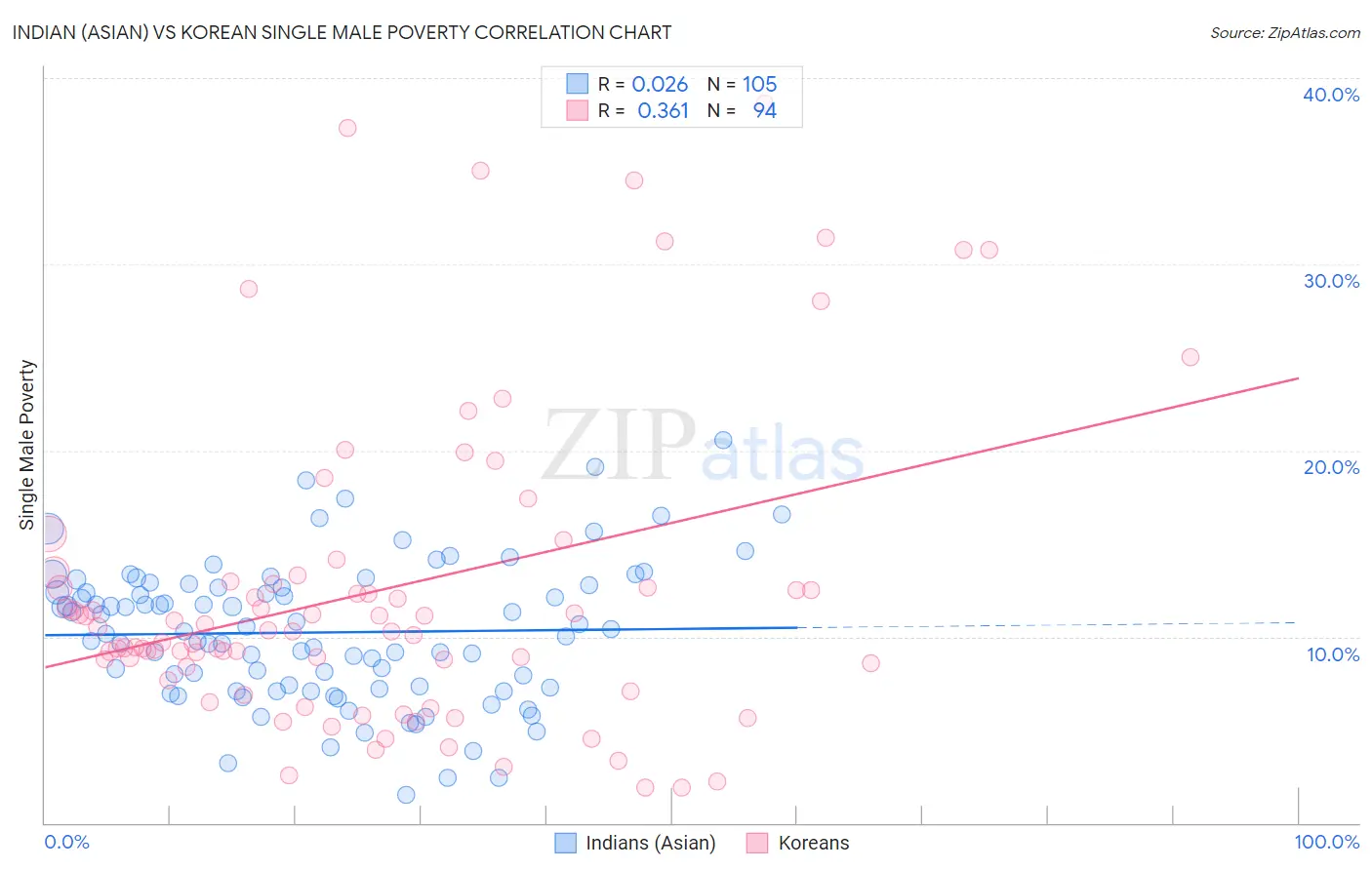Indian (Asian) vs Korean Single Male Poverty
COMPARE
Indian (Asian)
Korean
Single Male Poverty
Single Male Poverty Comparison
Indians (Asian)
Koreans
11.3%
SINGLE MALE POVERTY
100.0/ 100
METRIC RATING
24th/ 347
METRIC RANK
11.0%
SINGLE MALE POVERTY
100.0/ 100
METRIC RATING
15th/ 347
METRIC RANK
Indian (Asian) vs Korean Single Male Poverty Correlation Chart
The statistical analysis conducted on geographies consisting of 425,562,550 people shows no correlation between the proportion of Indians (Asian) and poverty level among single males in the United States with a correlation coefficient (R) of 0.026 and weighted average of 11.3%. Similarly, the statistical analysis conducted on geographies consisting of 437,940,785 people shows a mild positive correlation between the proportion of Koreans and poverty level among single males in the United States with a correlation coefficient (R) of 0.361 and weighted average of 11.0%, a difference of 2.5%.

Single Male Poverty Correlation Summary
| Measurement | Indian (Asian) | Korean |
| Minimum | 1.5% | 1.9% |
| Maximum | 20.6% | 38.6% |
| Range | 19.1% | 36.8% |
| Mean | 10.2% | 12.5% |
| Median | 10.3% | 10.3% |
| Interquartile 25% (IQ1) | 7.2% | 8.4% |
| Interquartile 75% (IQ3) | 12.7% | 13.0% |
| Interquartile Range (IQR) | 5.5% | 4.6% |
| Standard Deviation (Sample) | 3.8% | 8.3% |
| Standard Deviation (Population) | 3.7% | 8.3% |
Demographics Similar to Indians (Asian) and Koreans by Single Male Poverty
In terms of single male poverty, the demographic groups most similar to Indians (Asian) are Maltese (11.3%, a difference of 0.020%), Bolivian (11.2%, a difference of 0.20%), Immigrants from Japan (11.3%, a difference of 0.35%), Immigrants from Pakistan (11.2%, a difference of 0.41%), and Asian (11.2%, a difference of 0.50%). Similarly, the demographic groups most similar to Koreans are Chinese (11.0%, a difference of 0.050%), Immigrants from South Central Asia (10.9%, a difference of 0.62%), Immigrants from Afghanistan (10.9%, a difference of 0.74%), Bhutanese (11.1%, a difference of 0.75%), and Immigrants from Philippines (10.9%, a difference of 0.82%).
| Demographics | Rating | Rank | Single Male Poverty |
| Taiwanese | 100.0 /100 | #9 | Exceptional 10.9% |
| Immigrants | Fiji | 100.0 /100 | #10 | Exceptional 10.9% |
| Immigrants | Philippines | 100.0 /100 | #11 | Exceptional 10.9% |
| Immigrants | Afghanistan | 100.0 /100 | #12 | Exceptional 10.9% |
| Immigrants | South Central Asia | 100.0 /100 | #13 | Exceptional 10.9% |
| Chinese | 100.0 /100 | #14 | Exceptional 11.0% |
| Koreans | 100.0 /100 | #15 | Exceptional 11.0% |
| Bhutanese | 100.0 /100 | #16 | Exceptional 11.1% |
| Tsimshian | 100.0 /100 | #17 | Exceptional 11.1% |
| Immigrants | Bolivia | 100.0 /100 | #18 | Exceptional 11.1% |
| Immigrants | Moldova | 100.0 /100 | #19 | Exceptional 11.2% |
| Ethiopians | 100.0 /100 | #20 | Exceptional 11.2% |
| Asians | 100.0 /100 | #21 | Exceptional 11.2% |
| Immigrants | Pakistan | 100.0 /100 | #22 | Exceptional 11.2% |
| Bolivians | 100.0 /100 | #23 | Exceptional 11.2% |
| Indians (Asian) | 100.0 /100 | #24 | Exceptional 11.3% |
| Maltese | 100.0 /100 | #25 | Exceptional 11.3% |
| Immigrants | Japan | 100.0 /100 | #26 | Exceptional 11.3% |
| Immigrants | China | 100.0 /100 | #27 | Exceptional 11.4% |
| Immigrants | Asia | 100.0 /100 | #28 | Exceptional 11.4% |
| Immigrants | Egypt | 100.0 /100 | #29 | Exceptional 11.4% |